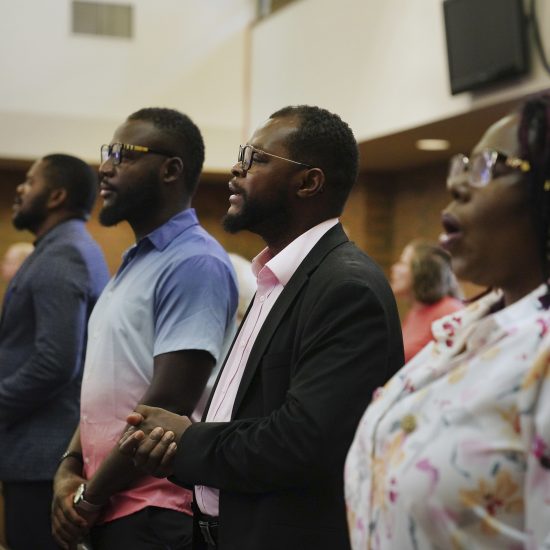

CLAIMING THE COURAGEOUS MIDDLE: Daring to Live and Work Together for a More Hopeful Future. By Shirley A. Mullen. Grand Rapids, MI: Baker Academic, 2024. Xiii + 186 pages.
Living in the middle can be dangerous. In a very polarized world, you likely will face significant opposition from both sides of the political or religious spectrum. Placing yourself in such a situation will take great courage. Yet, it may be an important and even necessary calling. When we speak of “claiming the courageous middle” we are not necessarily talking about being a centrist or moderate. It doesn’t involve a lack of convictions, relativism, or being “like warm.” Instead, claiming the courageous middle involves a willingness to stand in the gap and seek to build bridges between opposing positions/people. It’s a calling that, at least to me, seems rather attractive and needed at this moment in time. While many people love living at the poles, they often fail to achieve any tangible results. Instead, they build walls and fall prey to conspiracy theories. Is that what we need at this moment?

Robert D. Cornwall
Among those people who wish to see a different reality is Shirley Mullen, President Emeritus of Houghton College (New York), and the author of Claiming the Courageous Middle. Mullen is a long-time academic administrator, having served as President of Houghton College and as Provost at Westmont College (Santa Barbara, California). She has served in a variety of capacities with the Coalition of Christian Colleges and Universities and the National Evangelical Association. She is by confession an evangelical Christian (but not of the Trumpian kind). When she argues for claiming a courageous middle, she does so from an evangelical perspective. So, one might agree in principle with the premise while not always agreeing with the positions personally taken. She is rather clear on her position on abortion, though less clear on LGBTQ+ concerns. But perhaps we must enter the middle space to get anything done.
As someone who has spent much of his ministry over the past twenty-five years or so engaged in bridge-building, especially in interfaith spaces, I am attracted to Mullen’s message and calling. In many ways what she calls for here resonates with me. As I’ve pointed out, her starting place for engaging in this work is a bit different from where I find myself. She is an evangelical and I am postevangelical. Nevertheless, whatever our starting places, she offers us a pathway to a different way of existing in this world we inhabit.
If we’re to claim this courageous middle we’ll need to define the terms. Mullen suggests that the courageous middle involves working “actively in this middle space in such a way that we convene a new community of individuals who, together, can imagine a way forward out of the polarization that is dividing our families, our workplaces, our politics, and our churches. Instead of our collective creativity as a society being used to maintain our side — whatever that side is in a particular situation or on a specific issue — we are directing that energy forward in service to the common good.” (p. xi). As she writes of creating this courageous middle Mullen does show her cards as to where she stands on issues, such as abortion (she is pro-life) and LGBTQ+ (she appears to favor traditional views) but she wishes to engage with those with whom she differs to see if there is common ground to be found. That’s not an easy task.
Mullen addresses these and other topics from the perspective of someone who has spent several decades in Christian higher education where differences of viewpoint are regularly present among students, faculty, alumni, and other constituents. She has found herself on many an occasion in the middle of these discussions, seeking to find a solution that would bring people together.
Mullen begins in Chapter 1 “Catching a Vision for a Third Way of Being in the World” by telling her own story, beginning with her childhood which involved being the daughter of a Baptist pastor who had a separatist ethos. We follow her life story to college and graduate school, and a professional career in academia (she is a historian by training) that opened her up to broader visions of the world. It is her study of history that provides the foundation of this calling to the courageous middle. From there she moves in Chapter 2, titled “A Gift We Would Not Ask For,” to sharing why the courageous middle is important and why it takes courage to live in that middle space. Her point here is to address the charge that those who inhabit middle spaces are timid and need to choose their side. In response, she wants the reader to consider the complexity of the world and the issues facing us. With that in mind, she seeks to inspire a new generation of people to enter the middle of a polarized society, “motivated by the gospel of Jesus Christ and empowered by the Holy Spirit to choose to be hosts of middle space, turning this space from a place of timidity, passivity, and blandness to a space of redemptive and radically imaginative possibility” (p. 72).
Having shared her own story and inviting the reader to consider the value of inhabiting and working from this middle space, seeking to address our polarized world, she moves in Chapter 3 to introduce the witness of the biblical story into the conversation. She takes note of several biblical characters, whom she believes inhabited this middle space and therefore offers us exemplars. These include Joseph, Moses, Esther, Daniel, and Paul, as well as Jesus whom she calls the “Ultimate host of Middle Space.” While there isn’t necessarily an exact parallel between the experiences described in Scripture and now, she believes these examples offer us a theological home for those working in this area. I will note here that she tends to view these stories with a bit of flatness, such that she seems to portray characters such as Esther and Daniel as historical personages in ways that most biblical scholars would not. While it may appear that at points she takes the stories at face value, her point is well taken. These figures can serve as exemplars of the kind of work she invites us to engage in.
The final two chapters address the challenges facing those who engage in this kind of work and guidance for those, especially college students, who wish to prepare for such a calling. In Chapter 4, Mullen provides us with a risk analysis for engaging in this work, especially since it is likely that if you engage in this work, you will get hit from both sides. She also seeks to help those called to this work make sure they are rooted in their own convictions. It is important to have a strong anchor to engage in such work. We will need to weigh the short-term costs against the long-term benefits of such work. She writes: “The work of weighing the risks and benefits of middle space is the work of practical wisdom, the work of creativity, the work of faith in the realities that we cannot see, and the work of partnership in the great cosmic exchange that will someday trade out our spirit of heaviness for a garment of praise.” (p. 138). Chapter 5 reveals who might be the primary audience of this book, at least in the author’s mind. It is students and young adults who are concerned about the polarization of this world, and thus who might be open to such work. In other words, this might be used as a college textbook, likely at a Christian liberal arts college such as Westmont or Houghton. Her audience is, I would say, more conservative than me. That is fine. If we are to build bridges, people from both sides of the centerline will need to hear the call and be reminded of the costs and benefits of such an engagement.
At points, I struggled with the messaging, since I found myself looking back at an ideological/theological world I no longer inhabit. Yet, it is with people like Mullen that I will need to partner if we are to build bridges of understanding in pursuit of the common good. She provides in the fifth chapter suggestions regarding groups that work in middle spaces, some of which are interfaith in orientation. Since I have spent much of my life working in interfaith spaces, I greatly appreciated those references. It should be noted that people who participate in interfaith work bring to the conversation differing perspectives on important issues. Many Muslims for example are socially conservative, while Jews tend to be socially liberal. Hindus can be more liberal but not all. Yet, we enter that space seeking the common good.
A book like Shirley Mullen’s Claiming the Courageous Middle requires careful reading. It addresses an important concern, that is our increasingly polarized world, whether religiously or politically. We find families and churches, as well as friendships affected by these polarities. We may find ourselves conflicted in our relationships. Mullen reminds us that if we are to enter this middle space we need to be rooted in our own convictions, and that is worth noting. As one reads this book, especially if one lives on the left side of the middle, it is good to recognize the author’s starting point, and in many ways her primary audience, which is evangelical (of a non-Trumpian kind). As I read Claiming the Courageous Middle and agreed with her premise, I wondered whether there was a need for a corresponding book from a more liberal/progressive side, helping folks on my side of the center line understand the value of engaging with the “other side” in that middle space.
The challenge for those of us in the church is that our engagement within the Christian community is often colored by our partisan commitments. It has become increasingly true that we often define our faith commitments by our political ones. For that reason, whether we land politically or theologically where Mullen begins the conversation, I believe she is on to something as she lays out her thesis in Claiming the Courageous Middle. Hopefully, we’re not too late to claim that middle space that leads to a more hopeful future! I write this review while the 2024 elections are close at hand, with one of the candidates having survived an assassination attempt and questions abound about the two candidates’ fitness for office. As a result, the political tensions are rising overwhelming any middle spaces. Yes, it will take courage to inhabit such spaces.
You can also listen to Shirley Mullen on our Dangerous Dogma podcast here:
This review originally appeared on BobCornwall.com.
Robert D. Cornwall is an ordained minister in the Christian Church (Disciples of Christ). Now retired from his ministry at Central Woodward Christian Church (Disciples of Christ) of Troy, Michigan, he serves as Minister-at-Large in Troy. He holds a Ph.D. in Historical Theology from Fuller Theological Seminary and is the author of numerous books including his latest “Second Thoughts about the Second Coming: Understanding the End Times, Our Future, and Christian Hope” coauthored with Ronald J. Allen. His blog Ponderings on a Faith Journey can be found at www.bobcornwall.com.






